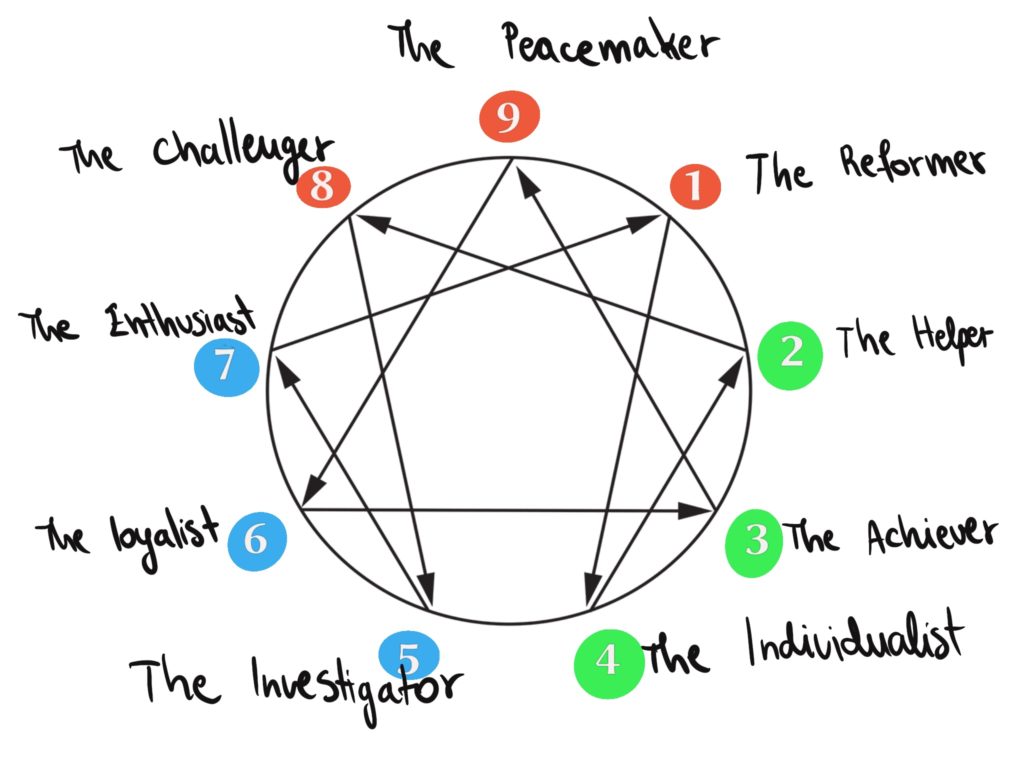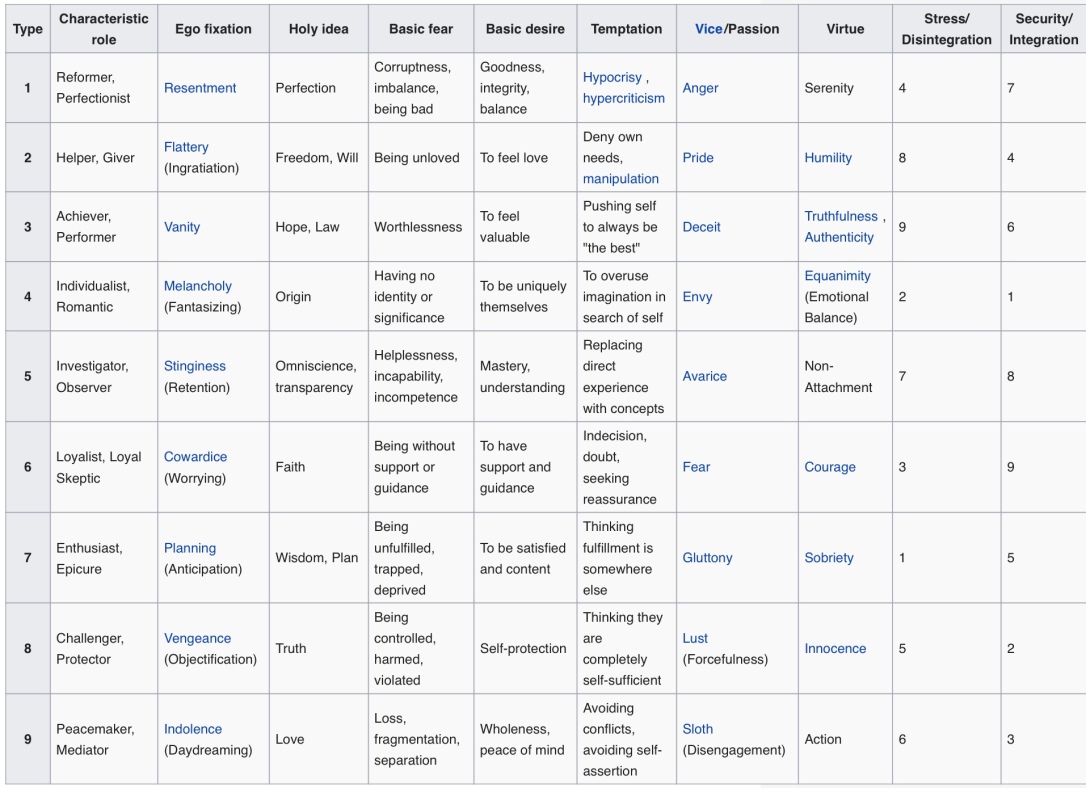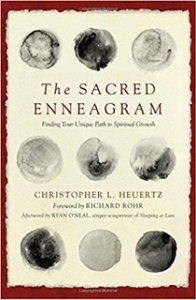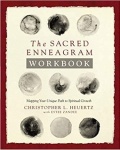
Settle in! This is a lengthy post. If you are interested in information about your personality type, the Enneagram is a helpful tool. And if you are interested in the Enneagram, or even curious about it, read on! If you’re not interested in any of that, wait for my next blog post.
“What’s your number?
That is the most frequently asked question about the Enneagram.
The second frequently asked question?
“What in the world is an Enneagram?”
Here’s the official definition according to the Merriam-Webster Dictionary:
en·ne·a·gram
noun
en·nea·gram | \ ˈe-nē-ə-ˌgram \ plural : enneagrams
Definition of enneagram
1. a regular geometric figure with nine points : the figure inscribed within a regular nine-sided polygon
2. a system of classifying personality types that is based on a nine-pointed starlike figure inscribed within a circle in which each of the nine points represents a personality type and its psychological motivations (such as the need to be right or helpful) influencing a person’s emotions, attitudes, and behavior).
Imposed Isolation and a Compromised Immune System
When one system is weak — my immune system — why not work on boosting another system? In this case, I mean my psychological system (which actually needs constant attention). So while I am in an immunosuppressed state of imposed isolation inside my house, I have taken some time to look back on the Enneagram notes I have used through the years. When I first studied the Enneagram, I was asking, “Who am I?”
I’m still asking! I now know that determining who I am is a life-long proposition, so I still need a season of introspection from time to time. Hence, I pulled out my Enneagram diagrams and notes. Let me say at the outset that no system can tell you who you are. The best the Enneagram can do is to offer a bit of insight into various personality types. It has been helpful for me, so I decided to share an Enneagram overview today.
I recently read several of Father Richard Rohr’s daily meditations focused on the Enneagram. He understands the Enneagram not merely as a personality typing system, but as a tool for personal transformation. In one of his daily meditations, Father Rohr says this about the Enneagram:
If you know the Enneagram already, my hope is that you will learn something new about yourself, someone you care about, or even someone you don’t care for very much. Compassion, empathy, and forgiveness—for the self and the other—are some of the great fruits of this labor. And if you aren’t familiar with the Enneagram at all, know that these meditations are simply pointing in the direction of a much greater wisdom to be explored.
Some History on the Enneagram
In the late 1960s, Oscar Ichazo began teaching the “Traditional Enneagram” as we know it today. The Enneagram is widely taught as a way of understanding personality, addiction, relationships, vocation and other areas that all of us need more fully understand. However, the Enneagram symbol has roots in antiquity and can be traced back at least as far as the works of Pythagoras. The philosophy behind the Enneagram contains components from mystical Judaism, Christianity, Islam, Taoism, Buddhism, and ancient Greek philosophy (particularly Socrates, Plato, and the Neo-Platonists)—all traditions that stretch back into antiquity. The Enneagram of Personality Types is a modern synthesis of a number of ancient wisdom traditions. (The Enneagram Institute)
People who know the Enneagram in a superficial way think it’s about putting people into boxes, but it actually works to free people from their self-created boxes. While there are tests and quizzes that can help individuals identify their primary Enneagram type, finding our “number” is just the first step. We get to know our “number” so we can begin freeing ourselves from the passions, fixations, and fears to which our ego has become attached. — Father Richard Rohr
As Father Richard would suggest, we should remember that the Enneagram does not definitively determine one’s personality type. Its nine categories are not meant to restrict us to a certain way of being or “name” us. Rather, it is a dynamic system that recognizes that humans are far too complex to fit easily into simple categories. It does, however, offer insight.
The Enneagram can be a powerful tool for self-discovery and spiritual transformation, but it shouldn’t be our only tool. The Enneagram is most helpful when used in conjunction with other practices like study, contemplation, therapy, spiritual direction, and life in community with others. The Enneagram’s most important purpose is to help us uncover the traps that keep us from being our best selves. That kind of insight is invaluable.
— From the Daily Meditations of Richard Rohr published on February 23, 2020
The Nine Personality Types
 Let’s begin by looking at a traditional Enneagram. The types are normally referred to by their numbers, but sometimes their “characteristic roles” are used instead. There are also “stress” and “security” points which are the types (called Wings) connected by the lines of the enneagram figure and are believed to influence a person who is in more adverse or relaxed circumstances. According to this theory, someone with a primary One type, for example, may begin to think, feel and act more like a Four type when stressed or a Seven type when relaxed.
Let’s begin by looking at a traditional Enneagram. The types are normally referred to by their numbers, but sometimes their “characteristic roles” are used instead. There are also “stress” and “security” points which are the types (called Wings) connected by the lines of the enneagram figure and are believed to influence a person who is in more adverse or relaxed circumstances. According to this theory, someone with a primary One type, for example, may begin to think, feel and act more like a Four type when stressed or a Seven type when relaxed.
The Enneagram Wings
Most, but not all, Enneagram of Personality theorists teach that a person’s basic type is affected to some extent by the personality dynamics of the two adjacent types as indicated on the enneagram figure. These two types are often called “wings”. A person with the Three personality type, for example, is understood to have points Two and Four as their wing types. A person may be understood, therefore, to have a core type and one or two wing types which influence but do not change the core type.
The Enneagram at a Glance
The table below offers some of the principal characteristics of the nine types along with their basic relationships. This table expands upon Oscar Ichazo’s ego fixations, holy ideas, passions, and virtues, primarily using material from Understanding the Enneagram: The Practical Guide to Personality Types (revised edition) by Don Richard Riso and Russ Hudson.

Every single person has access to all nine numbers. Based on nature, nurture, and discipline, you express the values of each number at varying degrees of intensity based on your lived experience. You are not one thing; you are complex and multifaceted; you are interconnected. This is a vital paradigm shift. When you consider having access to all nine numbers simultaneously, you increase and expand your capacity for thriving. [1]
Considering what you know of the Enneagram so far, in what numbers do you experience ease, or in Jerome Lubbe’s language, sense “efficiency”? Where do you feel less efficient? Great insight can be gained from Richard Rohr’s February 29th meditation that speaks of understanding the Enneagram as a Whole-Identity Profile instead of a single number personality “type,” He says that by seeing the Enneagram as a Whole-Identity Profile, one can expand their capacity for growth in infinite ways.
. . . When you shift the Enneagram Framework from being a number to having efficiencies in all nine numbers, the Enneagram language shifts with it. It becomes about nature and values instead of type and reductive behaviors. For example, number Seven, traditionally associated with the title of “Enthusiast,” is instead represented by the innate human capacity for “Enthusiasm” as well as the value of “Experiences.”
“I am an enthusiast” becomes “I value experiences” which allows more room for nuance, invites growth and begs the question, “. . . and what else do I value?”. . . There is no human who is defined by a single number.
If you have resisted being “pinned down” to any one Enneagram number, perhaps Lubbe’s approach will help you see all of these qualities within yourself. Take a few minutes to read the statements below aloud slowly, pausing for reflection after each one. Notice any sensations in your body. Observe the difference between the impact of “I am” statements versus “I value.” After reading all nine, where do you feel the most energy and resonance? What values are especially meaningful to you? What values do you want to spend more time cultivating? [1] https://cac.org/enneagram-part-one-body-center-weekly-summary-2020-02-29/
Jerome Lubbe’s Enneagram as a Whole-Identity Profile
Eight: I am a Challenger = I value Autonomy
Nine: I am a Peacemaker = I value Serenity
One: I am a Reformer = I value Justice
Two: I am a Helper = I value Appreciation
Three: I am an Achiever = I value Creativity
Four: I am an Individualist = I value Authenticity
Five: I am an Investigator = I value Clarity
Six: I am a Loyalist = I value Guarantees
Seven: I am an Enthusiast = I value Experiences [2]
When we understand the Enneagram as a Whole-Identity Profile instead of a single number personality “type,” we expand our capacity for growth . . . You are not a personality. You are not even multiple personalities. You have an identity—and what creates and characterizes your identity can be charted by the nine numbers of the Enneagram.
 The anatomy of the brain reflects this: we are not left-brained or right-brained, we are whole brained. [3] The same is true for the Enneagram.
The anatomy of the brain reflects this: we are not left-brained or right-brained, we are whole brained. [3] The same is true for the Enneagram.
To put it more plainly, you are not a personality type or number on the Enneagram. You are a whole person who has a whole identity — you are all nine numbers.
https://cac.org/enneagram-part-one-body-center-weekly-summary-2020-02-29/
Too Much Information?
This post may have been too much information for you. Or you may be interested in looking further into the Enneagram. If so, there are many excellent books on the subject as well as online information. You may also be asking how you can determine your Enneagram type. Online you will find many life coaches, spiritual directors, counselors, ministers and others who use Enneagram types with their clients/parishioners. Also at the end of this post I will list some websites that offer free tests that many be helpful to you, with the caveat that after you complete your test, they may offer you further information at a cost.
What’s most important is that whatever personality work you engage in leads you to a deeper knowing of yourself. The goal is to you know who you are, understand your behavior and use the information you have to guide your life journey and follow your dreams. No! The Enneagram test — nor any other personality test — will not make you into your best self. Only you can do that, through self-examination, prayer, contemplation and a process of clearing your soul of anything that might be holding you captive. My prayer for you is that you might search patiently and persistently for whatever brings you inspiration, insight, self-understanding and transformation.
P.S. — I’m a “Three!”
Online Enneagram Tests
The Enneagram Personality Test – Truity
This personality test is based on the Enneagram personality theory, which describes personality in terms of nine types, each driven by their own set of core emotions, fears, and beliefs. This basic 105 question test is free and takes about 10 minutes to complete. https://www.truity.com/test/enneagram-personality-test
The Fast Enneagram Test. https://enneagramtest.net/
Eclectic Energies Enneagram Tests
Offers two online Enneagram tests help you to determine which personality type you are. Your wing will also be indicated. https://www.eclecticenergies.com/enneagram/test
Additional Resources

Book: The Sacred Enneagram: Finding Your Unique Path to Spiritual Growth; Paperback – published September 5, 2017 by
For Further Study
Chris Heuertz, Enneagram Mapmakers: Exploring the Interior Landscapes of the Ego (Center for Action and Contemplation: 2020), podcast—coming March 24, 2020
Richard Rohr and Russ Hudson, The Enneagram as a Tool for Your Spiritual Journey (Center for Action and Contemplation: 2009), CD, DVD, MP3 download
Don Richard Riso and Russ Hudson, The Wisdom of the Enneagram: The Complete Guide to Psychological and Spiritual Growth for the Nine Personality Types (Bantam Books: 1999)
Richard Rohr and Andreas Ebert, The Enneagram: A Christian Perspective (The Crossroad Publishing Company: 2001, 2013)
References
[1] Jerome D. Lubbe, Whole-Identity: A Brain-Based Enneagram Model for (W)holistic Human Thriving (Thrive Neuro: 2019), 30-31. Artwork by Aimee Strickland; used with permission.
[2] Ibid., 32. Dr. Lubbe’s upcoming book, which will be available May 26, 2020, The Brain-Based Enneagram: You are not a number (vol. 1), will share his latest work on whole-brained interpretation of the Enneagram. See https://www.amazon.com/Brain-Based-Enneagram-Jerome-Lubbe/dp/173329452X/
[3] Dr. Jerome Lubbe, a functional neurologist and co-founder of Thrive NeuroTheology, has developed a science-based method to understand the Enneagram which he explores in his book, Whole-Identity: A Brain-Based Enneagram Model for (W)holistic Human Thriving


Love this, thank you. My project for the weekend, reflecting on what this might show me. ✨
Donna McGahee
>
LikeLike